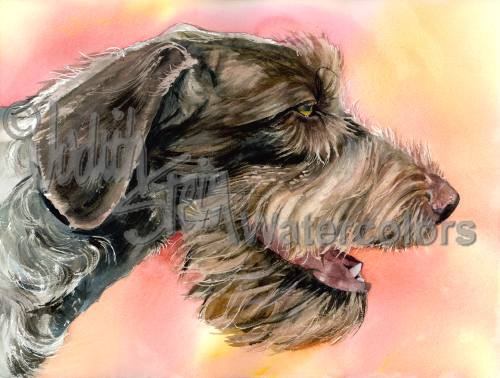
The breed earned its nickname, “the 4-wheel drive of hunting dogs” because these dogs will plow into briars or underbrush without hesitation – and 100 years after their inception, they are an homage to their breeders because the dogs still possess the qualities their creator envisioned. We’re talking about the Wirehaired Pointing Griffon.
Although the name “griffon” is French, and some of the breed’s development occurred in France, the WPG is pure Dutch in origin. Dutchman, Eduard Karel Korthals was an avid hunter and determined to create the perfect foot-hunter’s dog. The dog would have to be hardy enough to work the “polders” (the marshy low-lying ground common in the Netherlands), so its coat should be coarse and double coated. The dog shouldn’t stick out in its environment of the polders so that hunter and dog could sneak up on birds or fur-bearing game, therefore its color had to blend. The dog should excel on land as a pointer, but also in water as a retriever. It should work close, be resilient, and eager to please.
Korthals’ began his journey in 1874 with “Mouche,” the breed’s foundation bitch. The dog, “Janus,” “Satan,” “Banco,” “Hector,” and Junon” also factored into the early days of the breeding program. Korthals bred very carefully, and after some twenty years tweaking and perfecting, he created his vision of the ultimate hunting dog. At the time, his dogs were known as “Korthals’ Griffons” (and still are in some parts of Europe). Today, most breed fans simply call them “Griffs.”
Griffs were introduced in the United States in the late 19th century, and until the mid-1980s, the breed remained much as Korthals had developed it: A close working, versatile dog for the older or slower foot hunter. In the mid 80s, however, a North American group believed the breed needed an infusion of “outside” blood to bolster what they felt were deteriorating hunting instincts; they began to cross their dogs with the Cesky Fousek, a breed from Czechoslovakia with a hunting style and appearance some felt were similar to the German Wirehaired Pointer.These dogs have been called, “Foufons.”
WPG purists resisted “fiddling around” with Korthals’ vision, and felt that crossbred offspring of WPGs and Fouseks were no longer true griffons. We always defer to breed experts here, but it’s our understanding that in 1991, the AKC agreed and recognized the American Wirehaired Pointing Griffon Association as the parent club for the WPG in the U.S.
Today the WPG is a still relatively rare breed among sporting dogs. Only 410 were registered with the AKC in 2005 with a total of only 88 litters registered in the entire country in 2005. Why so few? It’s hard to know why, exactly. Griffons are said to be difficult to train to master levels in the field because they are exceptionally smart, and perhaps a bit softer than some other breeds. They have a great deal of natural ability but always figure a way out. Philippe Roca, a one time vice president of the American Wirehaired Pointing Griffon Association, was quoted in a “GUNDOG Magazine interview, “You simply cannot rush a Griffon.”
Griffs, like all whiskery dog breeds, are not best choice for a fastidious home as they can be sloppy drinkers, but they are pleasant, dignified, and we think utterly pleasing to the eye.
Image by Judith Stein
https://www.etsy.com/shop/k9stein
